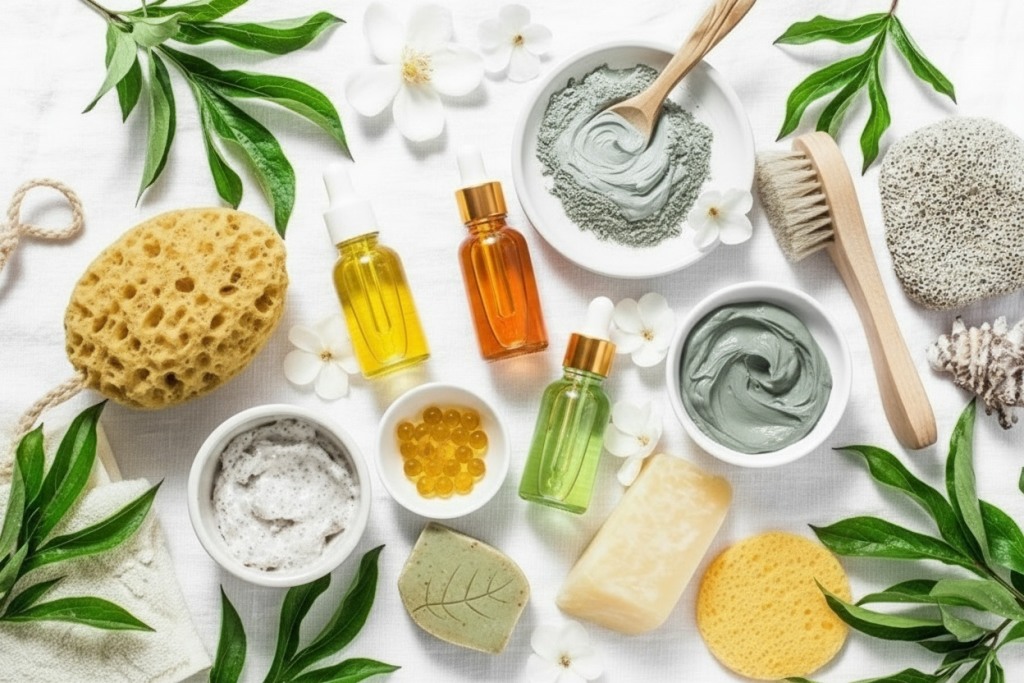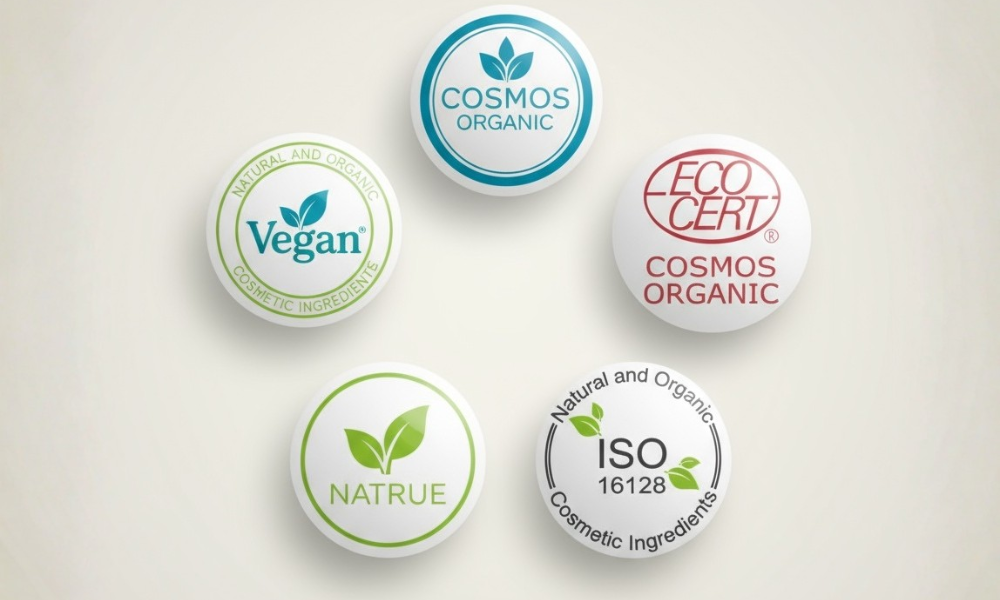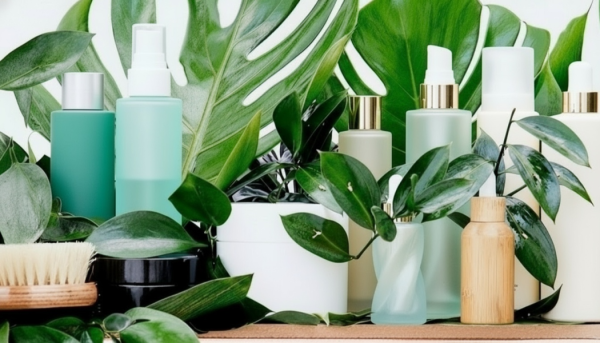The cosmetics market has witnessed a profound transition in recent years: from an initial demand focused on what is “natural” and “vegan”, towards a much more complex requirement based on authenticity, traceability and scientific backing. In this new landscape, consumers are no longer satisfied with eye-catching labels. They want evidence, provenance, controlled environmental impact and, above all, transparency throughout the entire value chain.
This article is aimed at entrepreneurs, niche brands and startups seeking to develop sustainable natural cosmetic lines, but with genuine differentiation based on technology, science and environmental commitment. We will explore the differences between natural, vegan and “clean beauty” cosmetics; the key role of green biotechnology; certification and regulatory standards; and how to effectively assess and communicate the sustainability of a formulation.
OEM/ODM laboratories such as MS Cosmetics Lab fulfil an essential role: translating these new demands into viable technical solutions, safe formulations and highly competitive products.
Natural, Organic, Vegan and Clean Cosmetics: The Real Differences
Technical and Legal Definitions
- Natural cosmetics: products that contain ingredients derived from natural sources (plant, mineral or animal) with minimal chemical processing. Depending on the country or certification, a minimum percentage of natural ingredients may be required.
- Organic cosmetics: includes natural ingredients cultivated without pesticides, chemical fertilisers or genetically modified organisms. Generally requires certifications such as COSMOS Organic or ECOCERT.
- Vegan cosmetics: contains no ingredients of animal origin or derivatives such as beeswax, lanolin or animal collagen. This does not necessarily mean that the product is natural.
- Clean beauty: a marketing term referring to cosmetics without “toxic” or questionable ingredients, although it lacks an official regulatory definition. Its interpretation varies according to brand.
Requirements for Ingredients, Certifications, and Processes
Each category involves different criteria for ingredient selection, manufacturing processes, and safety testing. For example:
- A natural product certified by COSMOS must have at least 95% natural ingredients of the total.
- A certified organic product additionally requires that a percentage of the plant-based ingredients come from organic farming.
- Vegan cosmetics may include synthetic ingredients, provided they are not of animal origin.
Evaluating Authenticity Beyond “Green Marketing”
Many brands benefit from greenwashing: they use terms such as “natural” without certified backing. It is crucial for entrepreneurs to understand how to validate the veracity of natural or organic claims, whether through:
- Accredited certifications
- Technical data sheets and certificates of analysis for ingredients
- Good Manufacturing Practices (GMP)
Common Cases of Confusion
- Products labelled as “natural” that contain silicones, PEGs, or synthetic fragrances
- Vegan cosmetics with petrochemical ingredients
- Clean beauty with “paraben-free” claims, but without evidence of real improvement in the formulation
Practical Example: Certified Natural vs. Nature-Inspired
A moisturiser with aloe vera extract may be called “nature-inspired”, even though it contains artificial fragrances, non-biodegradable preservatives, and synthetic colourants. In contrast, a certified natural formulation meets criteria for origin, biodegradability, environmental impact, and ingredient purity.
Sustainable Biotechnological Ingredients: The New Frontier
Introduction to Green Biotechnology in Cosmetics
Green biotechnology represents a natural evolution of cosmetics towards genuine sustainability. It’s not about replacing natural ingredients with synthetic ones, but rather optimising natural resources through clean technologies such as controlled fermentation, cell cultures, or enzymatic processes.
This discipline enables the development of highly effective cosmetic ingredients with a smaller environmental footprint, better traceability, and greater stability, without the need to overexploit ecosystems or depend on irregular harvests.
Concrete Examples of Biotechnological Ingredients

Bioferments: obtained through fermentation processes of plant extracts or other natural substrates. This process increases the bioavailability of active compounds, improves their stability, and enhances their antioxidant, moisturising, or anti-inflammatory benefits.
- Examples: fermented rice, lactobacillus with ginseng, fermented algae with high mineral content.
Natural enzymes: enzymes such as lipase, protease, or superoxide dismutase can be derived from natural sources through bioprocesses. They are used for their ability to gently exfoliate, repair cellular damage, or protect against free radicals.
- Applications: gentle peels for sensitive skin, anti-ageing formulations, restorative cosmetics for post-sun exposure.
Biomimetic actives: ingredients that mimic the skin’s natural mechanisms, such as the production of collagen, ceramides, or endogenous antioxidants. Synthesised using biotechnology, with structures similar to those found in nature.
- Advantages: better skin compatibility, low risk of reactivity, excellent efficacy even at low doses.
Benefits Compared to Conventional Ingredients
- Reduced use of agricultural land and water
- Continuous and scalable laboratory production
- Lower variability in quality and environmental impact
- Greater microbiological safety and technical stability
Integration in Cutting-Edge European Laboratories
Leading European laboratories in natural formulation are integrating biotechnology as a complementary tool to traditional botanical extracts. This enables the creation of more effective, safer products that align with modern consumer expectations: demonstrable efficacy and verifiable sustainability.
At MS Cosmetics Lab, we advise brands on the selection of these biotechnological ingredients, evaluating not only their cosmetic function, but also their origin, traceability, and environmental footprint.
Certifications, Audits and Regulatory Limits
Main International Certifications
For a natural cosmetics brand to be credible, it is not enough to simply declare intentions. There are international certifications that validate ingredients, processes and final products. Among the most relevant are:
- COSMOS (Soil Association, Ecocert, BDIH, Cosmebio, ICEA): regulates natural and organic cosmetics.
- ECOCERT: one of the most recognised certifications for organic cosmetics.
- NATRUE: promotes truly natural cosmetics.
- VEGAN Society: certifies the complete absence of animal ingredients.
- Halal: compliance with Muslim market requirements.
- ISO 16128: international standard for defining the percentage of natural ingredients.
What Do They Really Mean and What Are Their Limits?
These certifications offer external credibility and a common language in the market. However, they also have limitations:
- They may vary in requirements depending on the certifying body.
- Some do not cover aspects of packaging or the complete life cycle.
- The certification process can be costly for small brands.
Even so, having them makes a clear difference compared to products without verification.
Self-Declaration vs. Accredited Certification
A “self-declaration” as “natural cosmetics” may be based on internal criteria without validation. This generates mistrust in regulated markets. Accredited certification involves external auditing, complete technical documentation and continuous monitoring.
Traceability and Certified Ingredients
Traceability begins at the ingredient’s origin. This involves:
- Suppliers with their own certifications.
- Batches documented from their collection or synthesis.
- Sustainability declarations (such as LCA: Life Cycle Assessment).
MS Cosmetics Lab works with previously audited and validated suppliers. This ensures not only technical quality, but also consistency with each brand’s values.
Laboratory Support Throughout the Process
One of the major challenges for a brand starting out in natural cosmetics is navigating regulatory complexity. Therefore, the laboratory’s role is key:
- Guiding the selection of certified ingredients.
- Advising on documentation for certifications.
- Adapting formulations to required standards.
At MS Cosmetics Lab, we support every stage of the process, from ideation to final certification, with an OEM/ODM approach focused on regulatory compliance and responsible innovation.

How to Assess Real Sustainability in Formulations
Holistic Approach: Beyond Natural Origin
Sustainability in cosmetics is not limited to using “green” ingredients. It requires a holistic approach that considers the entire product life cycle (LCA), from raw material extraction to the end-of-life of the packaging.
A truly sustainable formulation evaluates:
- The origin and type of cultivation of ingredients
- The impact of transformation processes
- The energy used in manufacturing and transport
- Biodegradability and aquatic toxicity
- The product’s shelf life and preservation
Origin and Footprint of Ingredients
Not all natural ingredients are sustainable. For example, an essential oil may be natural but require vast cultivation areas, high water consumption, and generate emissions during distillation. It is crucial to assess:
- Geographical traceability
- Extraction method (mechanical, solvent-based, supercritical CO2)
- Sustainable farming certifications
Additionally, it is important to consider whether ingredients come from threatened species or if their extraction negatively affects local biodiversity.
Packaging Impact
Packaging represents a significant share of a product’s environmental footprint. A sustainable strategy may include:
- Recyclable or recycled materials (PCR)
- Refillable or reusable systems
- Minimalist design (less ink, lower weight)
Example: switching from a heavy glass bottle to one made of recycled PET can reduce CO2 emissions in transport by up to 60%.
Today, there are even packages made from bioplastics derived from plant waste, compostable options, or recycled fossil-based plastics, broadening the possibilities for sustainable differentiation.
Waste and Biodegradability
The formulation must consider post-use impact, that is, what happens to the product after application:
- Are the surfactants biodegradable?
- Do they accumulate in aquatic ecosystems?
- Does the preservative alter the environmental microbiota?
Laboratories should work with raw materials that have technical data sheets with indicators such as:
- OECD Test 301: biodegradability
- Acute aquatic toxicity (LC50)
In rinse-off formulations, such as gels or shampoos, this analysis is essential to reduce the ecological impact of daily use.
Measuring the Real Environmental Footprint (LCA, Carbon, Water)
Life Cycle Analysis (LCA) makes it possible to quantify a product’s total environmental impact. Tools such as Ecoinvent or SimaPro are used in advanced laboratories to calculate:
- Carbon footprint (CO2e)
- Water footprint (litres/kg)
- Primary energy consumption
Some brands already include these data in their product sheets or labelling, building a trust-based relationship with informed consumers.
At MS Cosmetics Lab we work with ecodesign criteria and sustainability data sheets for every formulation.
Good Laboratory Practices
A sustainable formulation starts in the laboratory, with responsible practices such as:
- Selecting certified suppliers (RSPO, COSMOS, ISO)
- Using cold processes that consume less energy
- Applying circular economy principles, such as reusing production waste
Priority is also given to developing concentrated or solid formulations, which require fewer preservatives, less packaging, and reduce the logistics footprint.
Real Cases of Sustainability Improvement
- Reformulating emulsions by reducing synthetic preservatives in favour of fermented alternatives
- Replacing artificial fragrances with biodegradable botanical distillates
- Incorporating actives obtained through biotechnology, reducing intensive extraction
These adjustments not only reduce environmental impact, but also enhance brand storytelling and increase competitive value.
Green Innovation: Examples That Go Beyond Marketing
Emerging Biotechnological Ingredients with Scientific Backing
Innovation in natural cosmetics is not based on trends, but on science. Currently, a new generation of ingredients is being developed through biotechnology, backed by clinical studies and peer-reviewed scientific publications.
Recent examples:
- Fermented marine exopolysaccharides, with moisturising properties superior to traditional hyaluronic acid
- Biomimetic peptides derived from algae, with proven anti-wrinkle activity
- Plant-based postbiotics that strengthen the skin microbiota and reduce inflammation
- Fermented amino acids that mimic the skin’s natural moisturising factors
- Biotechnological structural lipids compatible with the hydrolipidic barrier
These ingredients enable emerging brands to compete in quality and efficacy with dermatological products, without abandoning their natural commitment.
The main advantage is that, by being developed in controlled bioreactors, dependence on scarce raw materials is reduced, ingredient consistency is improved, and variations due to climatic or agricultural factors are eliminated.
Green Extraction Technologies
The methods of obtaining ingredients have also evolved. Clean technologies allow active ingredients to be extracted more efficiently, safely and sustainably:
- Supercritical CO2 extraction: leaves no solvent residues, is selective, and better preserves extract properties
- Directed enzymatic fermentation: improves the bioavailability of plant-based ingredients
- Molecular bioengineering: enables the production of rare or endangered actives without damaging their natural ecosystem
- Microwave distillation: reduces energy consumption and improves extract quality
Additionally, methods based on specific enzymes for selective release of bioactive compounds are being explored, increasing efficacy without the need for harsh extractants.
Ecological Reformulation of Traditional Products
Many brands are opting to reformulate their classic bestsellers under new sustainability standards:
- Replacing silicones with biodegradable and sensorially pleasant plant esters
- Eliminating microplastics and non-biodegradable nanoparticles
- Using preservatives derived from natural fermentation with low microbiological impact
Artificial colourants are also being replaced by purified mineral pigments and botanical colouring actives such as spirulina, hibiscus and annatto.
Reformulation does not imply a loss of efficacy, but rather an adaptation to the new regulatory context and the expectations of an informed consumer.
European Brands Applying Science to Back Their “Natural” Claim
Some niche European brands have managed to position themselves through a scientific approach to sustainability:
- Evolve Organic Beauty (United Kingdom): combines organic ingredients with enzymes derived from fruits through fermentation
- Gallinée (France): pioneer in pro-microbiome cosmetics with biotechnological postbiotics
- Twelve Beauty (Spain): uses high-purity actives extracted with clean technology and supported by clinical evidence
- Rowse (Spain): focuses on minimalist, bio-certified and ecologically formulated products
These brands demonstrate that it is possible to transcend marketing rhetoric with technical rigour and authenticity. Moreover, their success shows that consumers appreciate the combination of natural ingredients with transparent science.
How MS Cosmetics Lab Drives This Transition
At MS Cosmetics Lab, we work with a green innovation approach, combining cutting-edge technology with natural principles. Our R&D team evaluates ingredients not only by their origin, but by:
- Their technical performance
- Their complete traceability
- Their verified environmental footprint
- Their compatibility with international standards
We offer our clients:
- Reformulation of existing products under new sustainable criteria
- Development of new ranges with applied biotechnology
- Technical and regulatory advice for natural certifications
- Stability, compatibility and efficacy studies in partner laboratories
Our commitment is clear: to champion more responsible, scientific and competitive natural cosmetics. We believe in sustainable beauty that is not merely a trend, but a genuine evolution of the sector.
Furthermore, we support our clients from the conceptualisation phase through to final production, ensuring that every stage of the process complies with verifiable sustainability principles. This includes:
- Tailored selection of natural and biotechnological actives according to brand positioning
- Development of formulations adapted to demanding international regulations (EU, FDA, ASEAN)
- Prototypes and pilot testing to optimise textures, sensoriality and stability
We also work with a certified network of sustainable suppliers and promote the use of locally sourced or fair trade raw materials, thereby reducing the logistical carbon footprint.
In terms of packaging, we advise on the selection of recycled, biodegradable or innovative materials (such as bioplastics or plastic-free packaging), and collaborate with designers to integrate aesthetic and functional sustainability.
Our OEM/ODM model is distinguished by its ability to translate ethical narratives into commercially successful products. It’s not simply about formulation, but about building products with genuine, distinctive values that resonate with informed and discerning consumers.
Conclusion
Modern natural cosmetics demand far more than plant-based ingredients. They require validated authenticity, demonstrable traceability and a solid scientific foundation. In this context, green biotechnology does not replace nature, but complements and enhances it responsibly.
Brands that successfully integrate these principles will not only meet new consumer expectations, but will also earn the trust of distributors, regulators and strategic partners.
At MS Cosmetics Lab, we help you develop sustainable natural formulations with complete traceability and advanced biotechnology.
Contact us and let’s take your brand towards science-based green cosmetics with high competitive value.




